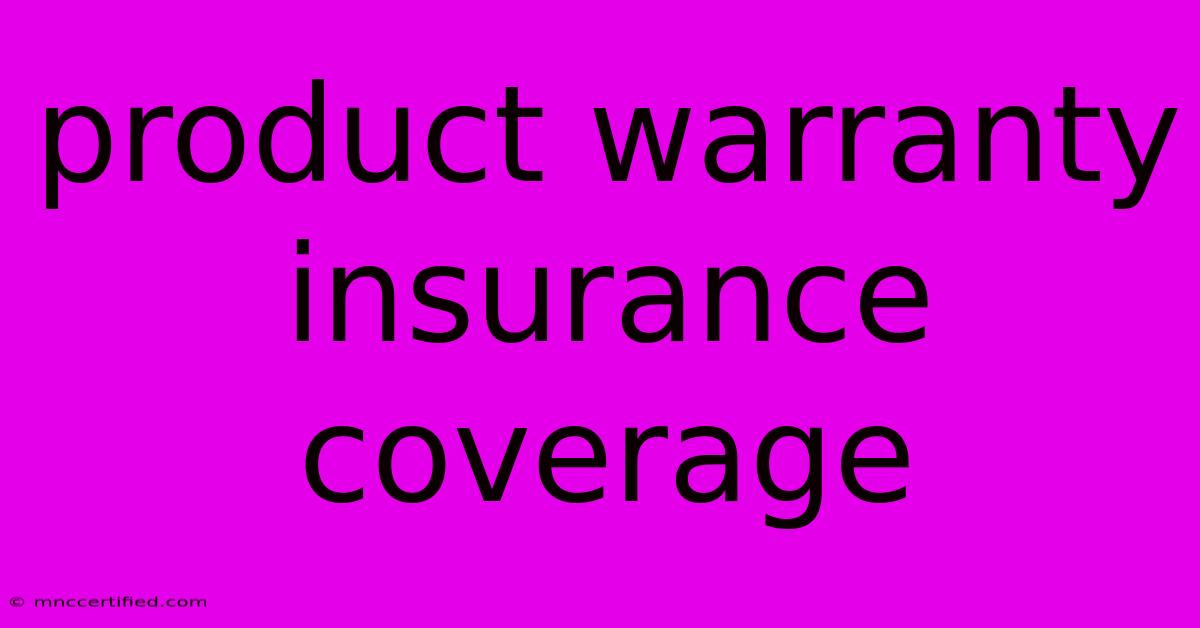Product Warranty Insurance Coverage

Table of Contents
Protect Your Purchases: A Guide to Product Warranty Insurance Coverage
In a world filled with technological marvels and everyday essentials, it’s easy to get swept up in the excitement of a new purchase. But what happens when that shiny new gadget breaks down or your beloved appliance starts malfunctioning? That’s where product warranty insurance comes in. This comprehensive guide will delve into the ins and outs of warranty insurance, helping you understand its benefits, limitations, and whether it's the right choice for you.
What is Product Warranty Insurance?
Product warranty insurance, also known as extended warranty or service protection plan, is an additional layer of protection you can purchase for your new products. It extends the manufacturer's original warranty, providing coverage for repairs or replacements beyond the initial period.
When Does Product Warranty Insurance Make Sense?
While not always necessary, product warranty insurance can be a valuable investment for certain products. Here's when it might be worth considering:
- High-Value Items: For expensive electronics, appliances, or gadgets, the cost of a potential repair or replacement could be significant. Warranty insurance can help offset these expenses.
- Products with a History of Reliability Issues: Certain brands or product lines might have a reputation for frequent breakdowns. Warranty insurance can offer peace of mind in such cases.
- Products with Complex Repairs: Appliances or electronics requiring specialized parts or expertise could lead to expensive repair costs. Warranty insurance can cover these expenses.
- Products Used Frequently: Items used heavily or in demanding environments may be more prone to wear and tear. Warranty insurance provides extra protection against unexpected repairs.
What Does Product Warranty Insurance Typically Cover?
While coverage varies depending on the specific policy and insurer, typical inclusions may include:
- Repairs: Covering the cost of parts and labor for repairs due to manufacturing defects or normal wear and tear.
- Replacements: Providing a replacement product if the original cannot be repaired within a reasonable timeframe.
- Accidental Damage: Protecting against damage from accidental spills, drops, or other mishaps.
- Extended Coverage: Extending the manufacturer's warranty period for a specified timeframe.
Important Considerations Before Purchasing
Before diving into a warranty insurance policy, it's crucial to consider the following:
- Cost: The price of warranty insurance varies based on product type, value, and coverage. Ensure you compare prices from different providers.
- Deductible: Many policies have a deductible, a fixed amount you'll pay out-of-pocket for each claim.
- Exclusions: Warranty insurance typically excludes certain types of damage, such as cosmetic wear and tear or damage caused by misuse. Carefully review the policy's exclusions.
- Claim Process: Understand the process for filing a claim, including the required documentation and potential waiting periods.
Alternatives to Product Warranty Insurance
While warranty insurance can be beneficial, there are alternative ways to protect your purchases:
- Manufacturer's Warranty: Most products come with a standard manufacturer's warranty, offering basic coverage for defects.
- Credit Card Protection: Certain credit cards offer purchase protection, which may cover damage or theft for a limited time.
- Homeowner's or Renter's Insurance: These policies might provide coverage for certain appliances and electronics under the personal property section.
Conclusion: A Wise Decision
Product warranty insurance can be a valuable investment, particularly for expensive or frequently used items. However, it's essential to carefully consider the cost, coverage, and potential downsides before making a decision. By understanding the nuances of warranty insurance, you can make informed choices to protect your purchases and enjoy peace of mind.

Thank you for visiting our website wich cover about Product Warranty Insurance Coverage. We hope the information provided has been useful to you. Feel free to contact us if you have any questions or need further assistance. See you next time and dont miss to bookmark.
Featured Posts
-
Can You Sue Your Insurance Adjuster
Nov 13, 2024
-
Kennewick Insurance Claim Attorneys
Nov 13, 2024
-
Costco Butter Recall Food Labeling Lessons
Nov 13, 2024
-
Follow The Nba Cup Schedule And Standings
Nov 13, 2024
-
My Chemical Romances The Black Parade Tour Is Back
Nov 13, 2024